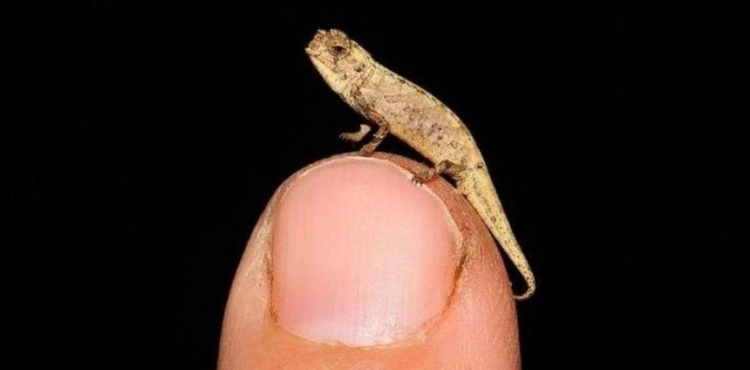A team of scientists announced the discovery of a chameleon, which was classified as the smallest known type of reptile on Earth, but warned that the continued elimination of forests in northern Madagascar threatens its survival.
These chameleons are so small that they can be placed on fingertips, the name "Procisia nana", and have a similar composition to that of the rest of the largest lizards in the world.
"We discovered (this type of animal) in a mountainous area in northern Madagascar," Frank Gallau, secretary of the department of herpetology at the Zoological Archives of the German state of Bavaria, told AFP.
He explained that a joint mission that included scientists from Germany and Madagascar discovered the two animals, a male and a female, in 2012, but did not realize that they were adults until a long time later.
"We discovered that the female body is white, and the male has large reproductive organs, so it was clear that they were adults," he added.
Glauw and colleagues reported in Scientific Reports that the male´s genitals are exceptionally large, accounting for nearly 20 percent of the body´s size.
The male’s body, which is the size of a peanut, is 13.5 millimeters long, with a nine millimeter tail.
In contrast, a female has a body size of 29 millimeters from the nose to the tip of her tail.
These are the only animals of this species to be found today.
Islands that were connected in ancient times to neighboring continental lands are famous for miniature copies of animals crossing ephemeral land bridges, a phenomenon known as "island dwarfism".
"There are many super-small vertebrates in Madagascar, including the smallest primates and some of the smallest frogs in the world," said Andulalao Rakuturison, a researcher at the University of Antananarivo, a co-author of the study.
However, the researchers concluded that the "island effect" does not apply to the animal species "Prokecia nana", which lives exclusively in mountainous areas at an altitude of 1,300 meters above sea level.
"We don´t have a good explanation for why these species are so small," Glau said.
What scientists know is that the tiny reptiles may be on the brink of extinction, although the International Union for Conservation of Nature, which is responsible for preparing the Red List of Threatened Species, has not yet completed its evaluation.
"The destruction of natural habitats is the biggest threat to amphibians and reptiles in Madagascar," Glau said, adding, "Perhaps in the future, climate change may be (a major threat), but deforestation" is the biggest threat now.
Since the mid-twentieth century, Madagascar has lost about 45 percent of its vegetation cover.
Procisia nana and another small chameleon species discovered by Glau and colleagues on a small island off the coast of Madagascar are in great danger due to their small size.
Madagascar is located in a "biodiversity hotspot" and is home to five percent of the world´s unique plant and animal species.
The island nation has one of the highest poverty rates in the world, and lacks the resources to conserve and manage natural resources.












